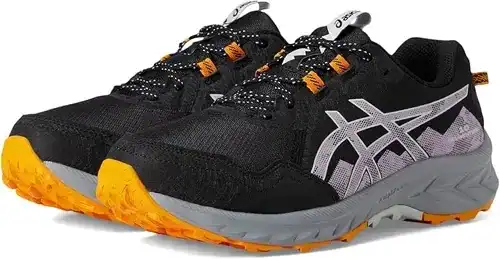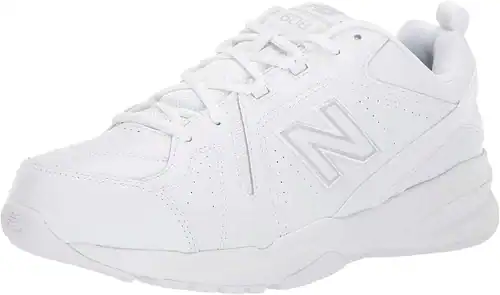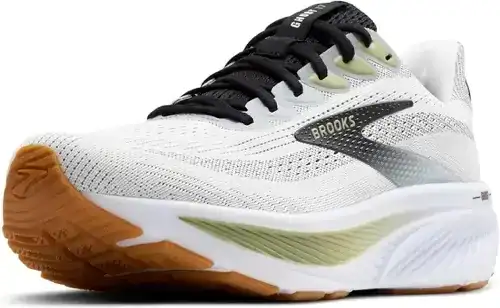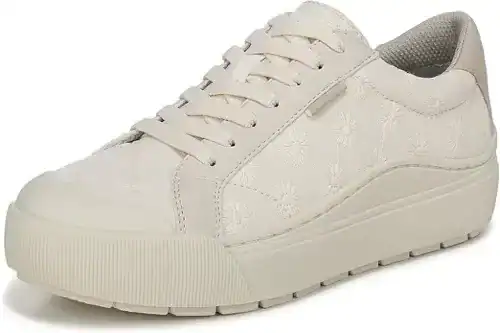Last Updated on July 16, 2025
Best Shoes for Hip Pain
As a man in my 50s who’s battled hip discomfort for years, I’ve learned that the right footwear can make a world of difference. After trying countless pairs, I’ve found shoes that deliver exceptional support, cushioning, and alignment—all crucial for alleviating hip pain. This guide highlights eight top-tier options—four designed with men in mind, and four tailored for women. Each pair is a latest 2025 model, available on Amazon, and selected based on features that help reduce hip strain. Whether you’re walking, working, or just getting through the day, these shoes could help you move more comfortably and confidently.
Summary of Best Shoes for Hip Pain
Summary Table
Shoe Model (Click to scroll to review) | Gender | Best for | Topic Features | Price |
|---|---|---|---|---|
Overpronators, stability | GuideRails, DNA Loft v3, APMA seal | |||
Trail & road, shock absorption | GEL tech, AMPLIFOAM, aggressive outsole | |||
Budget training, lightweight | Charged Cushioning, flexible mesh upper | |||
Walking, cross-training | ABZORB cushioning, rollbar support | |||
Neutral runners, comfort | Nitrogen-infused midsole, segmented sole | |||
Casual, cushioned wear | Cloud-like sole, memory foam | |||
Overpronators, long walks | GEL cushioning, stability across gait cycle | |||
Orthopedic support, easy-fit | Removable footbed, wide toe box |
In-depth Reviews for Best Shoes for Hip Pain
If you’re struggling with hip pain, these detailed reviews will help you find the right footwear. Each shoe below offers targeted support, cushioning, and stability to reduce strain on your hips.
Brooks Adrenaline GTS 24
Best for: Overpronators, stability

The Brooks Adrenaline GTS 24 is a top choice for those who experience hip pain due to overpronation or misalignment. It features Brooks’ latest DNA Loft v3 midsole cushioning, which is nitrogen-infused for a soft, springy ride that protects joints from repetitive impact. What sets this model apart is its GuideRails® support system, which helps keep excess knee and ankle movement in check—providing an indirect benefit to hip alignment and reducing associated strain.
Compared to the GTS 23, the 24 delivers improved responsiveness while remaining just as reliable. Whether you’re a daily walker or someone who spends long hours on your feet, the balance of cushioning and support helps promote natural motion while absorbing shock. Runners with mild stability needs will also appreciate the flexible transitions. The shoe is also certified by the APMA for promoting foot health.
Specs
- Weight: 10.1 oz (Men’s size 9)
- Technology: DNA Loft v3, GuideRails®
- Health focus: Hip pain, overpronation, knee and back discomfort
Pros
- Excellent for controlling gait mechanics
- Cushioned without feeling heavy
- Breathable upper with secure lockdown
Cons
- Narrow in the toe box for some
- Slightly firm for pure comfort-seekers
Buy: Men’s version | Women’s version
ASICS Gel-Venture 10
Best for: Trail & road, shock absorption

The ASICS Gel-Venture 10 is a versatile trail and walking shoe that offers generous GEL cushioning in the rearfoot, which reduces hip stress during footstrike. Its durable AMPLIFOAM midsole provides added shock absorption and resilience, making it ideal for those who experience discomfort from uneven terrain or long walks.
Version 10 is lighter and more breathable than the Venture 9, with improved foot lockdown and better grip. Whether you’re navigating sidewalks, hiking trails, or working on hard surfaces, the aggressive lug pattern ensures traction while helping maintain a steady stride—critical for maintaining hip alignment. The support may not rival a full stability shoe, but for neutral walkers with mild pain, this is a durable and budget-friendly solution.
Specs
- Weight: 11.3 oz (Men’s size 9)
- Technology: GEL cushioning, AMPLIFOAM midsole
- Health focus: Hip pain from impact or hard surfaces
Pros
- Great value for price
- Multi-surface traction
- Cushioned feel for daily use
Cons
- Limited arch support
- Not ideal for severe overpronators
Buy: Men’s version | Women’s version
Under Armour Charged Assert 10
Best for: Budget training, lightweight

Under Armour’s Charged Assert 10 is a lightweight training shoe that’s easy on the wallet and engineered with impact protection in mind. It features UA’s Charged Cushioning® midsole, which compresses to absorb shock and returns energy to reduce strain on your lower body, especially the hips. The upper is mesh-based, giving it breathability without compromising structure.
This model is a modest upgrade from the Assert 9, offering a more stable base and slightly more arch contour. While it doesn’t provide the deep support of orthopedic shoes, it works well for men who want a featherweight daily trainer that won’t aggravate their hips. It’s especially good for short walks, gym sessions, or everyday errands.
Specs
- Weight: 9.9 oz (Men’s size 9)
- Technology: Charged Cushioning®, EVA sockliner
- Health focus: Light support, shock reduction
Pros
- Affordable and widely available
- Flexible and breathable
- Great for casual wear
Cons
- Not enough support for overpronators
- Runs narrow for some feet
Buy: Men’s version | Women’s version
New Balance 608 V5
Best for: Walking, cross-training

The New Balance 608 V5 is a sturdy, comfortable walking shoe that doubles as a solid cross-trainer. Its standout feature is ABZORB® cushioning—placed in the heel and forefoot—which helps deflect impact forces that often travel up to the hips. A firm internal shank and supportive leather upper give the shoe extra stability, which many hip pain sufferers find reassuring during movement.
This model is especially suited for older adults or anyone looking for a no-nonsense shoe with long-lasting structure. While it leans heavier than mesh trainers, it offers protection and support that’s ideal for low-impact fitness and daily walking. With a slightly raised heel and wide sizing options, it caters well to those with mobility issues or arthritis.
Specs
- Weight: 14 oz (Men’s size 9)
- Technology: ABZORB, IMEVA midsole
- Health focus: Hip and knee impact, joint support
Pros
- Very stable and supportive
- Excellent shock absorption
- Durable leather construction
Cons
- Bulky feel
- Lacks modern flexibility
Buy: Men’s version
Brooks Ghost 17
Best for: Neutral runners, comfort

The Brooks Ghost 17 is a cushioned neutral shoe that performs beautifully for women or men dealing with hip pain from repetitive impact or long hours on their feet. The new DNA Loft v3 midsole is nitrogen-infused for lightweight cushioning, delivering a soft but responsive ride. It’s especially helpful for women with neutral gait who still experience hip discomfort, as the shock absorption is centered in the heel and midfoot—two pressure zones that contribute to hip fatigue.
The updated engineered mesh upper molds better to the foot than the Ghost 16, while the segmented crash pad smooths transitions for a more fluid stride. If you walk or run regularly, this shoe’s balance of softness and structure makes it a reliable option.
Specs
- Weight: 8.8 oz (Women’s size 8)
- Technology: DNA Loft v3, Segmented Crash Pad
- Health focus: Hip pain, plantar pressure relief, smooth gait
Pros
- Plush and protective ride
- Smooth heel-to-toe transition
- Breathable upper
Cons
- Not suited for severe overpronation
- Slightly bulky for short walks
Buy: Men’s version | Women’s version
Dr. Scholl’s Time Off Sneaker
Best for: Casual, cushioned wear

If you’re looking for stylish, pain-relieving shoes for everyday wear, Dr. Scholl’s Time Off Sneaker is a standout. It pairs a retro look with a super-cushioned, supportive insole system. The BE FREE® Energy Technology insoles feature three distinct zones for cushioning, pressure dispersion, and stability, which together help reduce tension in the hips and lower back.
This sneaker is vegan, lightweight, and made with sustainable materials. While it isn’t built for distance walking or training, it’s an excellent option for casual activities like errands or office wear. The roomy toe box and lightweight structure make it one of the most comfortable women’s lifestyle sneakers for people managing mild hip pain.
Specs
- Weight: Approx. 9 oz
- Technology: BE FREE Energy footbed
- Health focus: All-day standing, light walking, hip tension
Pros
- Supportive memory foam insole
- Sustainable materials
- Easy to style with outfits
Cons
- Not ideal for athletic use
- Limited arch control
Buy: Women’s version
ASICS Gel Kayano 32
Best for: Overpronators, long walks

IMAGE PLACEHOLDER
The ASICS Gel Kayano 32 is a premium stability shoe, ideal for women experiencing hip pain from overpronation or imbalanced gait. Its new PureGEL™ tech in the rearfoot works with FF BLAST™ PLUS ECO cushioning to soften impact while providing the necessary structure for high-mileage walks or light running. This is the most cushioned version of the Kayano line to date, delivering smooth, energy-efficient strides.
Its updated upper uses an adaptive mesh to reduce irritation, and a low-profile heel counter helps lock in the foot. Women with flat feet or inward rolling strides will benefit most, as this shoe keeps everything aligned and reduces torque on the hips.
Specs
- Weight: 9.2 oz (Women’s size 8)
- Technology: PureGEL™, FF BLAST+ ECO, 4D Guidance System™
- Health focus: Overpronation correction, hip and knee joint support
Pros
- Excellent arch and gait support
- Softer feel than prior Kayano models
- Eco-conscious materials
Cons
- Expensive
- Runs a bit long
Buy: Women’s version
OrthoComfoot Women’s Orthopedic Slip-On
Best for: Orthopedic support, easy-fit

For those needing orthopedic-grade support in a casual, convenient shoe, the OrthoComfoot Slip-On offers relief without sacrificing simplicity. It features a removable arch-supporting insole designed to align the foot and reduce pressure across the knees, hips, and back. The wide toe box helps avoid compression of the forefoot, while the slip-on construction makes it ideal for people with limited mobility or arthritis.
These shoes are great for indoor use, casual strolls, or travel. The design prioritizes joint-friendly structure over athletic performance, so it’s not for workouts—but for general daily use, it hits all the marks for hip-pain sufferers.
Specs
- Weight: Approx. 8 oz
- Technology: Orthotic arch insert, EVA shock-absorbing sole
- Health focus: Hip pain, plantar fasciitis, sciatica
Pros
- Orthopedic-grade footbed
- Easy slip-on access
- Good for travel and errands
Cons
- Not athletic or high-traction
- Basic styling
Buy: Women’s version
Buyer’s Guide: Choosing the Best Shoes for Hip Pain
Why Shoe Choice Matters for Hip Pain
The shoes you wear have a direct impact on your hips. Every step you take sends force upward through your feet, ankles, knees, and ultimately, your hip joints. Poorly designed or worn-out shoes can worsen pain by misaligning your body, increasing joint impact, and throwing off your natural stride. On the flip side, well-designed shoes can cushion your joints, stabilize your gait, and reduce muscular fatigue—all of which play a critical role in managing or reducing hip discomfort. For people who stand for long hours or walk frequently, hip pain can become a daily battle. Choosing footwear that reduces this stress is one of the most effective non-invasive steps you can take.
Look for shoes that specifically support alignment and absorb shock. When the foot strikes the ground, good footwear will control excess motion, especially if you have flat feet, overpronation, or a tendency to roll inward or outward. For those with arthritis, sciatic pain, or old injuries, these features become even more crucial. When evaluating your options, comfort should not come at the expense of stability—both are vital. Even shoes with a softer, plush feel should offer firm heel counters, arch structure, and midfoot security to prevent excessive motion that can radiate pain up to your hips.
Key Features to Look For in Hip-Friendly Shoes
When selecting shoes for hip pain, prioritize a combination of cushioning, stability, and alignment control. Cushioning should be soft enough to absorb shock, but not so mushy that it causes instability. Look for proprietary foam technologies such as Brooks’ DNA Loft v3 or ASICS’ FF Blast+ ECO, which are engineered to provide impact protection while retaining structure. These midsoles help deflect some of the force that would otherwise travel up to your hips.
Stability is another core requirement. People with hip pain often have biomechanical issues like overpronation or uneven leg length, which can worsen with shoes that lack support. Shoes featuring medial posts, GuideRails, or 4D guidance systems will help control motion and prevent your foot from rolling too far inward or outward. That in turn helps your knees and hips stay aligned. Additionally, look for wide toe boxes to allow natural toe splay, and deep heel cups to center your stride and prevent overcompensation.
The outsole also plays a role. A well-structured outsole ensures a smooth heel-to-toe transition, which is important for keeping the hips from jolting with every step. While trail shoes offer grip and terrain support, walking and running shoes often offer the most advanced gait-stabilizing technologies. Finally, don’t overlook the upper—lightweight mesh or leather that hugs the midfoot can prevent unnecessary foot shifting that throws off your stride and aggravates hip joints.
Should You Choose Running, Walking, or Orthopedic Shoes?
Each type of shoe serves a slightly different purpose, and which one you choose will depend on your lifestyle and type of hip pain. Running shoes are often a great choice—even if you don’t run—because they’re designed to absorb impact and guide the foot through a smooth stride. They typically feature the latest in cushioning and gait-support technology, which can significantly help people with chronic or recurring hip pain. If you’re someone who walks long distances or wants a daily-use trainer, a neutral or stability running shoe can be your best bet.
Walking shoes, on the other hand, are usually more rigid with flatter soles. They’re ideal for those who prioritize stability over flexibility and aren’t looking for the same level of rebound or responsiveness found in running shoes. These shoes are often built for durability and support over long periods of standing or casual movement, making them suitable for workplace settings or light errands.
Orthopedic shoes are another category entirely. These are designed specifically for people with medical foot and joint conditions. They often feature removable insoles, extra-deep heel cups, and enhanced arch support. While they may not have the performance appeal of running shoes, they are indispensable for people with mobility challenges, arthritis, or a history of joint surgery. The key is to match your activity level and health needs with the right shoe type, rather than choosing a shoe purely based on marketing or appearance.
Final Tips Before You Buy
Before purchasing, assess how your hip pain shows up in your day-to-day life. Does it worsen with walking? Is it aggravated by standing still? Do you feel it more on one side of your body? These clues can help you determine whether you need more cushioning, more stability, or possibly a wider shoe to offset asymmetry in your gait. Make sure you try on shoes at the end of the day when your feet are slightly swollen—this gives you a more accurate fit.
If you’re shopping online, always review the product specs and buyer feedback. Look for terms like “arch support,” “shock absorption,” “gait correction,” or “APMA-approved.” And don’t underestimate the value of trying different shoes until you find what works. Everyone’s anatomy is different, and even the best-rated shoe might not suit your specific hip needs.
For even better results, consider pairing your shoes with orthotic inserts designed to support your gait. Many of the shoes recommended above are compatible with custom or over-the-counter insoles, which can further align your lower body and help reduce chronic pain. Finally, don’t forget to replace your shoes regularly—midsoles compress and wear down over time, reducing their effectiveness and potentially reintroducing the very pain you were trying to eliminate.
Looking to explore more options?